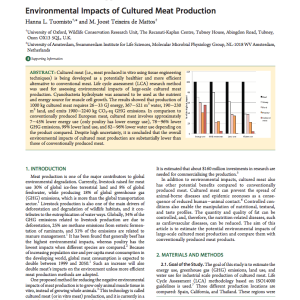
FCRN network member Hannah Tuomisto has co-authored a life cycle analysis of (hypothetical) in-vitro meat production here: Tuomisto H L, Teixeira de Mattos M J (2011) Environmental Impacts of Cultured Meat Production. Environ. Sci. Technol. dx.doi.org/10.1021/es200130u
ABSTRACT: Cultured meat (i.e., meat produced in vitro using tissue engineering techniques) is being developed as a potentially healthier and more efficient alternative to conventional meat. Life cycle assessment (LCA) research method was used for assessing environmental impacts of large-scale cultured meat production. Cyanobacteria hydrolysate was assumed to be used as the nutrient and energy source for muscle cell growth. The results showed that production of 1000 kg cultured meat requires 26-33 GJ energy, 367-521 m3 water, 190-230 m2 land, and emits 1900-2240 kg CO2-eq GHG emissions. In comparison to conventionally produced European meat, cultured meat involves approximately 7-45% lower energy use (only poultry has lower energy use), 78-96% lower GHG emissions, 99% lower land use, and 82-96% lower water use depending on the product compared. Despite high uncertainty, it is concluded that the overall environmental impacts of cultured meat production are substantially lower than those of conventionally produced meat.
You can download this here.
For more on the FCRN website on artificial meat see here.
For as regards other non conventional ‘meat’ sources insects have also been considered by some (and are of course also eaten in many parts of the developing world anyway). There are a couple of studies on insects/mealworms etc on the FCRN website here.







Post a new comment »